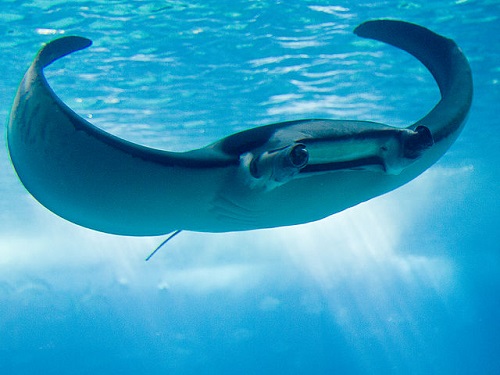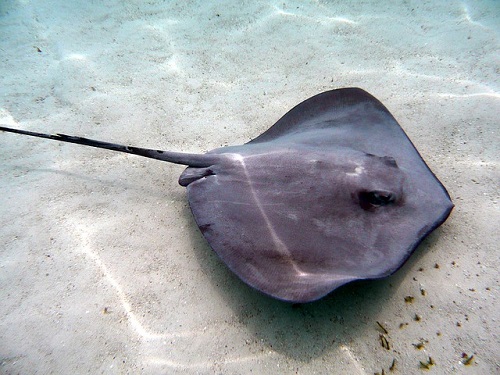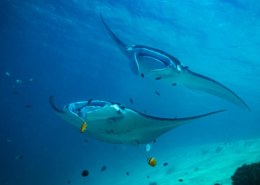Manta ray vs Stingray – Facts, Body Structure, Habitat, Size And Lots More
Manta rays and Stingrays are closely related and look similar are first glance bringing the debate on Manta ray vs Stingray, but there are actually big differences separating the two.
Manta ray vs Stingray
What Are Manta rays
Manta Rays are very large rays that belong to the Manta
They are classified as among the Myliobatiformes (which are stingrays and their relatives) and are placed in the Myliobatidae family (eagle rays).

manta ray
There are two species of Manta rays, birostris, which can reach up to 7m (23ft 0in) in width, and the much smaller M. alfredi, which can reach widths of up to 5.5m (18ft 1in).
Both species of Manta ray are cartilaginous, and have large triangular pectoral fins, and possess large horn-shaped cephalic fins, with mouths that are located on the forward-facing side of their bodies.
The large cephalic fins form a funnel-like structure which aids in feeding. While Manta rays are swimming, these fins are rolled into a spiral.
Manta rays are found predominantly in tropical saltwater locations, although can also be found infrequently in subtropical and warm temperate salt waters.
Both Manta species are pelagic, however alfredi tends to be a resident to coastal waters, while M. birostris migrates across the open oceans either singly, or in very large groups.
Both species are also filter feeders, where they swallow large quantities of water in their mouths as they swim, ingesting large amounts of zooplankton, which are later filtered out from the water by their gill rakers.
The gestation period in Mantas lasts for over a year, and they give birth to live pups.
Mantas often visit cleaning stations, where they seek the aid of cleaner fish to remove parasites.
Similar to whale behavior, they breach, however the reasons for this behavior is unknown.
Both species are listed on the International Union for Conservation of Nature (IUCN) as vulnerable.
This vulnerable status has come from a variety of anthropogenic threats including fishing net entanglement, pollution and hunting for harvesting their gill rakers as a use in traditional Chinese medicine. Their slow reproduction rates exacerbate these threats.
They have a protected status in international waters, from the Convention on Migratory Species of Wild Animals (CMS), however they are far more vulnerable, the nearer to shore they are.
What Are Stingrays
Stingrays are small rays that are cartilaginous fish, which are more closely related to sharks.
They belong to the suborder Myliobatoidei, of the order Myliobatiformes and consist of eight different families: Plesiobatidae (deepwater stingrays), Urotrygonidae (round rays), Hexatrygonidae (sixgill stingray), Urolophidae (stingarees), Dasyatidae (whiptail stingrays), Gymnuridae (butterfly rays), Potamotrygonidae (river stingrays), and Myliobatidae (eagle rays).

stingray
The majority of stingrays have one or more stingers that are barbed (these are modified from dermal denticles) on their tails. These are exclusively used in self-defense.
A stingray’s stinger can reach up to 35cm (14in) in length, and has two grooves on the underside which have venom glands.
The entire stinger is covered in a thin skin layer, which is called the integumentary sheath. This is where the venom is concentrated.
Some members of the suborder Myliobatoidei do not have stingers, such as the Manta rays and porcupine rays.
Stingrays inhabit a variety of waters around the world, including tropical, subtropical and temperate waters. Some species are also found in freshwater locations.
Some stingray species such as Plesiobatis daviesi are found in the deep ocean, while others such as Dasyatis thetidis are found in warm temperate oceans.
Most Myliobatoids are considered demersal (meaning they inhabit the next-to-lowest zone within the water column). However, some, such as the eagle rays and pelagic stingray, are pelagic.
There are currently 220 known species of stingrays that are organized into 10 families and 29 genera.
Many stingray species are becoming progressively threatened and vulnerable to extinction, primarily due to unregulated fishing.
In 2013, 45 species were listed as vulnerable or endangered by the IUCN.
Body Structure
Both Manta Rays and Stingrays usually have a flattened body shape with cartilaginous body composition related to sharks.
Although Manta rays do not possess a stinger or barb on the tail while stingrays on the other hand do possess a stinger or barb on the tail.
Habitat
Manta rays live predominantly in tropical and subtropical salt waters, while stingrays can also be found in warm temperate waters, as well as some species living in freshwater habitats.
Size
Manta rays are much larger is size, and are proportionately much wider than they are long.
Stingrays on the other hand, are generally much smaller in size and are proportionately much longer in length than they are wide.
Diet
The manta’s mouth is in the front of its body, Manta rays are filter feeders that feed exclusively on Zooplankton in the water column,
A stingray searches on the bottom for food as its mouth is underneath, stingrays are bottom feeders that eat various different species of crustaceans and mollusks. Some species generate a suction force that pulls the prey beneath.
Credit:



Leave an answer
You must login or register to add a new answer.